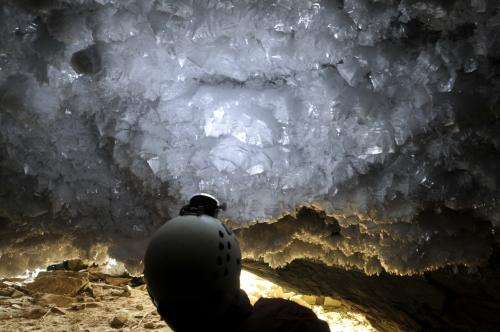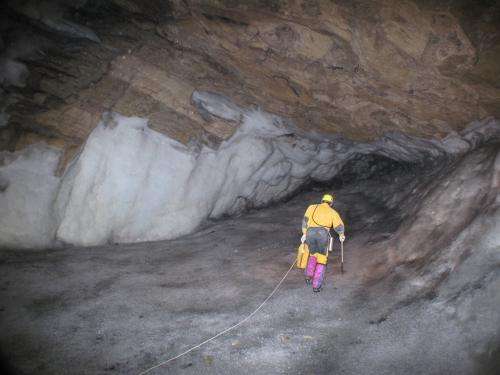Caves point to thawing of Siberia

Evidence from Siberian caves suggests that a global temperature rise of 1.5 degrees Celsius could see permanently frozen ground thaw over a large area of Siberia, threatening release of carbon from soils, and damage to natural and human environments.
A thaw in Siberia's permafrost (ground frozen throughout the year) could release over 1000 giga-tonnes of the greenhouse gases carbon dioxide and methane into the atmosphere, potentially enhancing global warming.
The data comes from an international team led by Oxford University scientists studying stalactites and stalagmites from caves located along the 'permafrost frontier', where ground begins to be permanently frozen in a layer tens to hundreds of metres thick. Because stalactites and stalagmites only grow when liquid rainwater and snow melt drips into the caves, these formations record 500,000 years of changing permafrost conditions, including warmer periods similar to the climate of today.
Records from a particularly warm period (Marine Isotopic Stage 11) that occurred around 400,000 years ago suggest that global warming of 1.5°C compared to the present is enough to cause substantial thawing of permafrost far north from its present-day southern limit.
A report of the research is published in this week's Science Express. The team included scientists from Britain, Russia, Mongolia and Switzerland.

'The stalactites and stalagmites from these caves are a way of looking back in time to see how warm periods similar to our modern climate affect how far permafrost extends across Siberia,' said Dr Anton Vaks of Oxford University's Department of Earth Sciences, who led the work. 'As permafrost covers 24% of the land surface of the Northern hemisphere significant thawing could affect vast areas and release giga-tonnes of carbon.
'This has huge implications for ecosystems in the region, and for aspects of the human environment. For instance, natural gas facilities in the region, as well as power lines, roads, railways and buildings are all built on permafrost and are vulnerable to thawing. Such a thaw could damage this infrastructure with obvious economic implications.'
The team used radiometric dating techniques to date the growth of cave formations (stalactites and stalagmites). Data from the Ledyanaya Lenskaya Cave – near the town of Lensk latitude 60°N – in the coldest region showed that the only period when stalactite growth took place occurred about 400,000 years ago, during a period with a global temperature 1.5°C higher than today. Periods when the world was 0.5-1°C warmer than today did not see any stalactite growth in this northernmost cave, suggesting that around 1.5°C is the 'tipping point' at which the coldest permafrost regions begin to thaw.
Dr Vaks said: 'Although it wasn't the main focus of our research our work also suggests that in a world 1.5°C warmer than today, warm enough to melt the coldest permafrost, adjoining regions would see significant changes with Mongolia's Gobi Desert becoming much wetter than it is today and, potentially, this extremely arid area coming to resemble the present-day Asian steppes.'
More information: "Speleothems Reveal 500,000-Year History of Siberian Permafrost," by A. Vaks et al., Science, 2013.
Journal information: Science Express
Provided by Oxford University


















